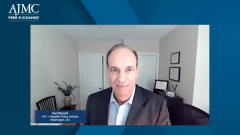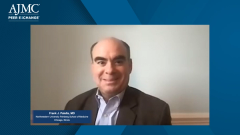
Understanding Implementation of USPSTF Guidelines for HIV PrEP
Ryan Bitton, PharmD, MBA, and Frank J. Palella, MD, discuss facts about the implementation of USPSTF guidelines for HIV PrEP therapy.
Episodes in this series

Ryan Haumschild, PharmD, MS, MBA: Thank you. It’s such a complex topic or not complex, but we need to roll it out, questions come up. We know that our friends at the Affordable Care Act like their facts and it helps drive more education and utilization around this. Earlier this year, to be more specific in the summer of 2021, regarding the implementation of these guidelines, they released some facts regarding the Affordable Care Act Implementation Part 47. I’d like to discuss these facts just in more detail. I know we’ve hit on a lot of these already, but as payers and providers are working through these facts, these are questions that come up. Basically, Health and Human Services and these departments release these facts to just answer some of the common questions that come up from stakeholders so that they can help the end-users and the administrators of these plans better understand the law and benefit that was intended. It allows some of our clinical stakeholders to follow these HIV pre-exposure prophylaxis [PrEP] clinical practice guidelines in some of those supplementations. Let’s delve into these facts more. I’ll start again with you, Ryan. I always appreciate your insights as our payer, but are payers required to provide coverage without cost-sharing for items or services that this committee recommends should be received prior to receiving the prescribed PrEP? Is that something you’re seeing? Is that something you’re doing? Talk to us about some of those items that need to be received prior to PrEP therapy being prescribed.
Ryan Bitton, PharmD, MBA: The answer is yes. The guidance is pretty clear on that. Specifically, what does that look like? I don’t know that I have the input. But yes, we are reacting to that and providing those for 0 cost-sharing. That’s our interpretation of the guidelines, and that’s what they were trying to propose that we do.
Ryan Haumschild, PharmD, MS, MBA: Excellent. It sounds like there is uptake from payers to really, again, as Frank talked about earlier on not just the treatment, but some of this other associated cost to decrease those barriers to care. We’ve talked a lot about barriers, so it’s great to see some of us being able to work through those. From that, Frank, I want to come back to you and ask you from your clinical perspective, as a practitioner from a generic and branded drug perspective, do you see payers adhering to these requirements? We’ve heard Ryan’s doing it. Ryan is kind of one of these leaders that we look to in manage care piece and helping drive some of these decisions, but what are you seeing and are you seeing what we’ve talked about adherence from payers for these facts? Because I know you treat patients across a number of insurances in different payer groups. What are you seeing kind of in real practice? Are they adhering to these requirements?
Frank J. Palella, MD: It’s an evolving story. Increasingly, the situation is getting better. If we look at what these facts, these guidelines, are targeted at establishing, it’s a leveling of the playing field at establishing of expectations on the part of not only providers, but clearly on the part of third-party payers. The payers are evolving into an understanding of what these expectations mean to maintain standards of care. However, there is not uniformity across payers. Sometimes, or often, what the prescribing provider deems as the most appropriate preventive therapy for HIV might not be the least costly for the payer and herein lies the rub sometimes so that we sometimes have to make a case. We must provide a rationale as to our understanding and justifications for using maybe something more modern than what the payer would choose to compensate for. I also, to a lesser extent, the periodicity and frequency of the follow-up. We’ve talked here primarily about barriers to initiation of PrEP. There are equally urgent barriers to the maintenance of PrEP that involve screening, that involve assessments, and responses to interruptions in PrEP because people tend to go on and off such therapy, as they perceive their own sexual risk. These are all issues that require flexibility and adaptability, not only on the parts of clinicians, but on the parts of payers. I hope I’ve answered your question sufficiently enough.
Ryan Haumschild, PharmD, MS, MBA: Yes. I like your answer. What I’m taking away is it depends. Some payers may be more at the forefront, some not. Some are doing coverage, but they’re trying to make step at it or trying to do a pharmacoeconomic assessment of which therapy they want to provide to manage this. We recognize those external pressures of managing a budget. That’s a responsibility of all payers to be steward of dollars, but how do we do it looking at the total cost of care and how that patient can be kind of adherent and effective on therapy and consider the benefit to the patient and not just that acquisition cost, which sometimes is a struggle. It’s interesting. I enjoyed your context. I liked also how you spoke about some of the testing, some of the monitoring, some of the counseling that comes with PrEP therapy.
Transcript Edited for Clarity
Newsletter
Stay ahead of policy, cost, and value—subscribe to AJMC for expert insights at the intersection of clinical care and health economics.






























































